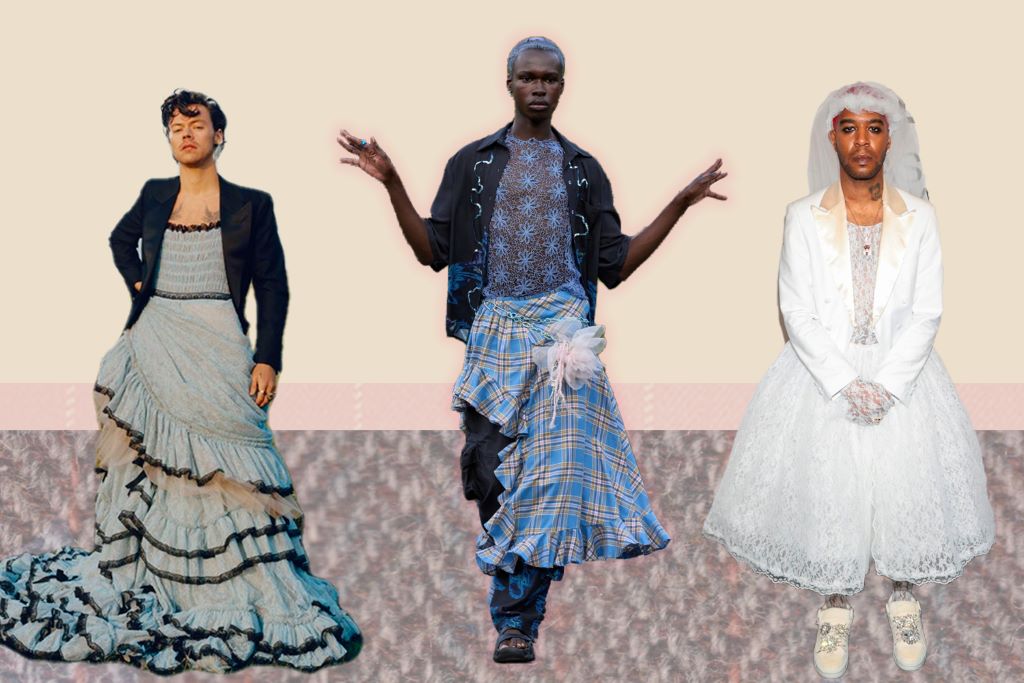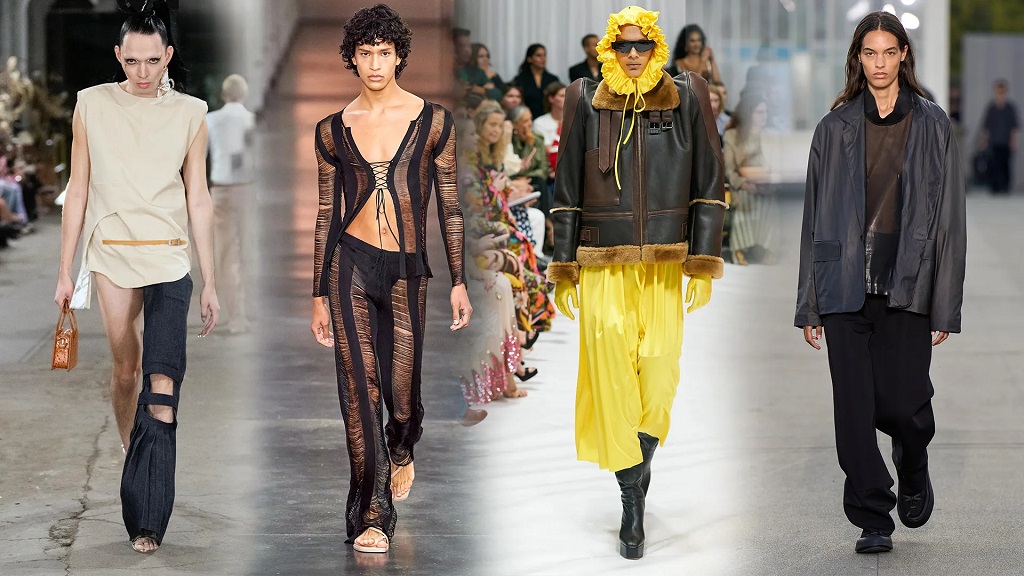In a world where conformity often reigns, the question persists: why do men wear dresses? Society has long grappled with the complexities of gender expression, but it’s high time we break free from the shackles of stereotypes. For those who dare to challenge the norm, the allure of guys wearing dresses is a captivating journey into the uncharted realms of self-expression.
Beyond the fabric and stitches lies a profound statement—a testament to the evolving landscape of masculinity. This exploration unveils the multifaceted motivations driving men to embrace the elegance of dresses, ushering in a new era where garments know no gender boundaries. So, let’s delve deeper into the intricate tapestry of reasons behind a man wearing dress and unravel the threads of transformation, one hemline at a time.
Cross-Dressing as a Form of Gender Expression
Cross-dressing is not a new concept; it has been practiced throughout history and across cultures. At its core, cross-dressing is a way for individuals to express their gender identity in a manner that may not align with their assigned sex at birth. It’s a way to break free from the constraints of societal expectations and embrace one’s true self. And for some men, wearing dresses is just one way to do that.
In a world where clothing has been arbitrarily assigned gender roles, cross-dressing allows individuals to reclaim their power and assert their right to self-expression. By blurring the lines between traditional masculine and feminine fashion, men in dresses challenge the rigid constructs of gender and open up a space for fluidity. This form of gender expression can be empowering, liberating, and even revolutionary.
Fashion Trends and Gender Fluidity
Fashion is a powerful tool for self-expression, and trends are constantly evolving. The blurring of gender lines in fashion has led to a more inclusive and accepting society. Men wearing dresses is no longer an anomaly; it’s a reflection of the growing acceptance of gender fluidity in our culture. With designers like Marc Jacobs, Thom Browne, and J.W. Anderson featuring men in dresses on the runway, it’s clear that fashion is embracing this new wave of gender expression.
But it’s not just high-end fashion brands; even mainstream retailers are breaking away from traditional gendered clothing sections. Brands like H&M and Zara have launched “gender-neutral” collections, further blurring the lines between men’s and women’s fashion. This shift in the industry not only gives men more options for self-expression but also challenges societal norms and paves the way for a more inclusive future.
Challenging Traditional Gender Roles
Traditional gender roles have often dictated what is considered appropriate clothing for men and women. Men were expected to be masculine, which meant wearing pants and shirts, while women were expected to be feminine, wearing dresses and skirts. However, as society progresses, these rigid distinctions are being challenged and redefined. Men wearing dresses is a clear example of breaking away from these traditional roles and embracing a more fluid approach to gender expression.
By defying societal expectations, men in dresses are challenging the idea that clothing should be limited by gender. It’s a form of rebellion against the outdated norms that have been imposed on us for far too long. As more men embrace this form of self-expression, it chips away at the foundation of gender stereotypes and opens up a world of possibilities.
Clothing Choices and Gender Identity
For many men who wear dresses, it’s not just about clothing; it’s about expressing their true gender identity. Some may identify as genderqueer, genderfluid, or transgender, and wearing dresses is a way to align their outward appearance with their inner sense of self. It’s a powerful statement of self-acceptance and authenticity, rejecting societal pressures to conform to binary gender norms.
It’s important to note that not all men who wear dresses identify as non-binary or transgender. For some, it may simply be a fashion choice or an expression of their individuality. But for those who do, wearing dresses is a way to embrace and celebrate their true gender identity, and that should be respected and celebrated.
The Cultural Significance of Clothing
Clothing has always carried cultural significance. In various societies, different garments symbolize status, tradition, or even rebellion. When men choose to wear dresses, they are making a statement about their identity and their beliefs, challenging the status quo and advocating for acceptance. It’s a powerful way to disrupt the norms and promote inclusion.
In many cultures, men have been wearing dresses for centuries. From the Scottish kilt to Indian dhoti, there are numerous examples of traditional male attire that includes dresses or skirt-like garments. By embracing these cultural influences, modern men in dresses are reclaiming and honoring their heritage while also challenging Western notions of gender.
Mainstream Fashion and the LGBTQ+ Community
The LGBTQ+ community has played a significant role in pushing the boundaries of fashion. As the community gains more visibility and acceptance, its influence on mainstream fashion grows. This inclusivity has paved the way for men to explore different clothing choices, including dresses, without fear of judgment. The fashion industry, in turn, has responded by featuring more diverse models and embracing gender-fluid designs.
Men wearing dresses may still face discrimination and stigma in many parts of the world. But with mainstream fashion embracing this form of gender expression, it’s clear that society is moving towards a more accepting future. And as long as individuals continue to embrace their true selves and challenge societal norms, the world will become a more welcoming place for all forms of gender expression.
Social Acceptance and Redefining Masculinity and Femininity
Society is gradually becoming more accepting of diverse expressions of masculinity and femininity. Men who wear dresses are redefining these terms, proving that one’s choice of clothing doesn’t determine their worth or identity. It’s a step toward a more inclusive and open-minded world. By breaking down the barriers of traditional gender roles, we are opening up space for everyone to express themselves freely.
Furthermore, men in dresses serve as powerful role models for younger generations. As they see individuals confidently embracing their true selves, they learn that there is no one way to be a man or a woman. This can lead to healthier and more diverse expressions of gender identity and can positively impact society as a whole.
Gender Non-Conformity and the Fashion Industry
The fashion industry, once dominated by traditional gender norms, is evolving. Designers and brands are now actively promoting gender-neutral and gender-fluid clothing lines, which not only cater to a broader audience but also encourage gender non-conformity. The rise of men wearing dresses on the runway and in advertisements is a clear indication that fashion has become more inclusive and accepting.
As consumers become more conscious about supporting brands that promote diversity and inclusion, the fashion industry is responding by embracing gender non-conformity. This not only benefits individuals who want to express themselves freely but also opens up new avenues for creativity and innovation within the industry.
Celebrity Fashion Choices and Influence
Celebrities have a powerful impact on fashion trends and social norms. When well-known figures proudly wear dresses, it sends a message of acceptance and encourages others to embrace their true selves. It’s a reminder that fashion is a means of self-expression, not a rigid set of rules. And when celebrities use their platform to promote inclusivity and diversity, it can have a significant impact on society as a whole.
In recent years, we’ve seen male celebrities confidently embrace dresses on the red carpet and in everyday life. This has not only sparked important conversations about gender expression but also helped to break down barriers and challenge societal expectations.
Gender-Bending Fashion: A Means of Freedom
Gender-bending fashion is all about defying expectations. It’s a way to celebrate the beauty of fluidity and the freedom to be oneself. By wearing dresses, men can break free from the limitations of traditional clothing and explore the vast spectrum of fashion. It’s a powerful form of self-expression that has the potential to challenge and change societal norms.
Artistic Expression in Fashion
Fashion is an art form, and like any other art, it allows for boundless creativity. Men who wear dresses are often expressing their artistic sensibilities, using clothing as a canvas to convey their unique style and perspective. By embracing different forms of gender expression, the fashion industry is becoming more diverse and dynamic, creating space for individual voices to be heard.
In conclusion
In the world of fashion, there exists a captivating enigma that demands our attention: why do men wear dresses? The conventional barriers of gender attire are being challenged, and it’s time to acknowledge the profound reasons behind guys wearing dresses.
Stereotypes have long dictated that dresses are exclusively for women. However, when we delve into the motivations driving the phenomenon of dresses for guys, we unearth a multifaceted tapestry of self-expression, gender identity exploration, and societal evolution.
Men who embrace dresses are not merely donning fabric; they are bravely dismantling preconceived notions of masculinity. Their choice to defy conventionality is an act of empowerment that challenges us all to reconsider the boundaries of fashion.
So, next time you encounter a man confidently rocking a dress, remember that it signifies a revolution in progress. It’s a reminder that the future of fashion is fluid, limitless, and inclusive. Embrace it, celebrate it, and together, let’s continue to break the chains of stereotypes that bind us.
FAQs
- Are men who wear dresses always transgender or gender non-conforming?
- Not necessarily. Some men who wear dresses identify as transgender or gender non-conforming, but others may simply enjoy the style and find it comfortable or aesthetically pleasing.
- Is cross-dressing the same as being transgender?
- No, they are different. Cross-dressing refers to wearing clothing typically associated with a different gender, while being transgender means a person’s gender identity differs from their assigned sex at birth.
- How can society be more accepting of men wearing dresses?
- Society can become more accepting by promoting gender diversity and encouraging open-mindedness. Education, representation in media, and respectful dialogue are essential steps towards greater acceptance.
- Are there specific fashion brands that cater to gender-neutral clothing?
- Yes, many fashion brands now offer gender-neutral clothing lines. Some popular ones include ASOS, H&M, and Zara, but the list is continually growing.
- Can women wear traditionally male clothing without judgment?
- Absolutely! Just as men can wear dresses, women can wear traditionally male clothing. The key is to break free from rigid gender norms and allow everyone to express themselves as they see fit.





